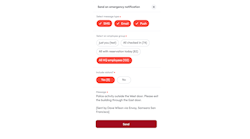K-12 school administrators have a critical need to know the identity of each person on campus, which is best done with visitor management software that makes it easy to quickly flag visitors who either should not be on campus or need to be handled differently than other campus guests.
Managing this function with paper logs exposes school districts to dangerous vulnerabilities. While this method of keeping track of visitors is perceived as quick and easy, it provides very little security and presents a number of problems, including:
- More often than not, the names are not legible or are false;
- In an emergency such as a fire, it would be impossible to quickly determine who is still in the building because the names can’t be read and the check-out times are not always required or enforced;
- Information regarding who has visited the campus is readily available for everyone to see when this information should be kept confidential; and
- There is no ability to leverage visitor analytics to better understand trends and patterns.
To address these issues, both large and small districts and their campuses are now implementing automated visitor management solutions — and integrators help school administrators increase security using ID card systems.
By adding visitor management software solutions, integrators can help their customers enhance campus security while simultaneously improving convenience by integrating the software with the school’s access control system. With the right visitor monitoring and management solution in place, schools can ensure that all campus visitors are authorized to be there, and have been officially checked in. At the same time, schools can build a historical visitor database that enables valuable analytics along with the ability to create reports, flag people who are not allowed on campus, and alert campus administrators and other stakeholders when there is a visitor issue.
Key Features to Sell
Visitor management software should simplify badging by enabling administrators to create and manage badge templates by category, and to create and manage all of the user accounts for the staff members who will be operating the badging software. Ease of use is critical and the overall system should be so simple that all necessary training takes no more than an hour.
Other considerations include the ability to set up and manage an automated, scheduled employee import process so that the visitor list is always up-to-date. Additionally, it should be possible for each badging station’s setting and options to be managed from the central administrator console. Finally, districts should also be able to use visitor management systems to help ensure that only authorized parental custodians are dropping off and picking up children from campus. This is done by optionally printing and issuing permanent barcoded ID cards for parents and caretakers — rather than temporary visitor badges — simplifying guest sign-in and check-out while streamlining the student drop-off and pick-up process.
There are a number of other key features for integrators to look for when recommending solutions for their customers. A particularly valuable feature is the ability to integrate the visitor management with the school district’s access control system, so that all information entered into the visitor management system during check-in is seamlessly passed to the access control system. With this approach, attendants at each campus do not have to be familiar with the access system in order to provide temporary card privileges to visitors. The process is simple: an access card for the visitor is activated in the access system using the information entered into the visitor software. Upon the visitor’s departure, he or she is checked out by the visitor lobby system and the associated card is automatically deactivated.
If visitors accidentally take their cards with them, the facility will still be secure because the visitor software passes the expiration date and time to the access system. After the specified date and time, the access card will no longer be valid and will not open anything.
Benefits of Integration
Integrating the visitor management solution with the access control system creates opportunities to derive many additional benefits from an organization’s access control system. In one example, a school district needed to streamline check-in processes for tardy students while improving attendance. To solve the problem, the district instituted a universal, mandatory student ID system that would enable them to improve classroom attendance across the district while enhancing campus security. They deployed an automated student management system and desktop card printers with associated software for producing customized, multi-purpose student ID cards. The system enables campus officials at each school location to instantly issue ID cards to all students.
Some schools use ID cards for additional purposes such as checking out books at the media center or purchasing lunches in the cafeteria. Elementary schools are also exploring the use of ID cards to encourage positive reinforcement of good behaviors, and for fund-raising initiatives. For instance, the cards can be used to monitor purchases at participating stores and restaurants that donate a portion of proceeds to the school. Additionally, cards could be used to monitor attendance on field trips and for access control at school sporting and entertainment events.
Integrating visitor management with access control also eliminates the need to maintain a supply of live cards at the reception desk for those who forget their ID badge. Since the visitor system has a record of all visitors who have been provided an access card, there is always a complete audit trail including information about the dates and times when cards were active.
Adding Value
Another consideration for integrators is whether the visitor management solution they propose is connected to police, so visitors with criminal records can be identified instantly. In this implementation, the visitor management system can be used to issue a warning alert to the lobby attendant so that, within seconds, he or she knows if a registered sex offender is trying to check in. Additionally, an automatic email alert can be sent to other school administrators and/or security personnel, if desired.
Integrators can add further value by recommending printing solutions for both access control and companion visitor management systems. As school districts become more reliant on their ID cards, it makes sense to be able to produce cards on demand, in high volumes, at many locations.
Today’s card printers, materials and software work together to deliver fast and efficient instant issuance capabilities. They also optimize card security by incorporating visual and logical technologies for multi-layered validation. Printer choices include monochrome direct-to-card (DTC) solutions and high definition printing (HDP) retransfer technology that can be used to create contactless or contact smart cards. There also is the option of high-throughput solutions that optimize performance and productivity.
Brett St Pierre is the director of business development, Education Solutions with HID Global. To request more info about the company, visit www.securityinfowatch.com/10213866.



